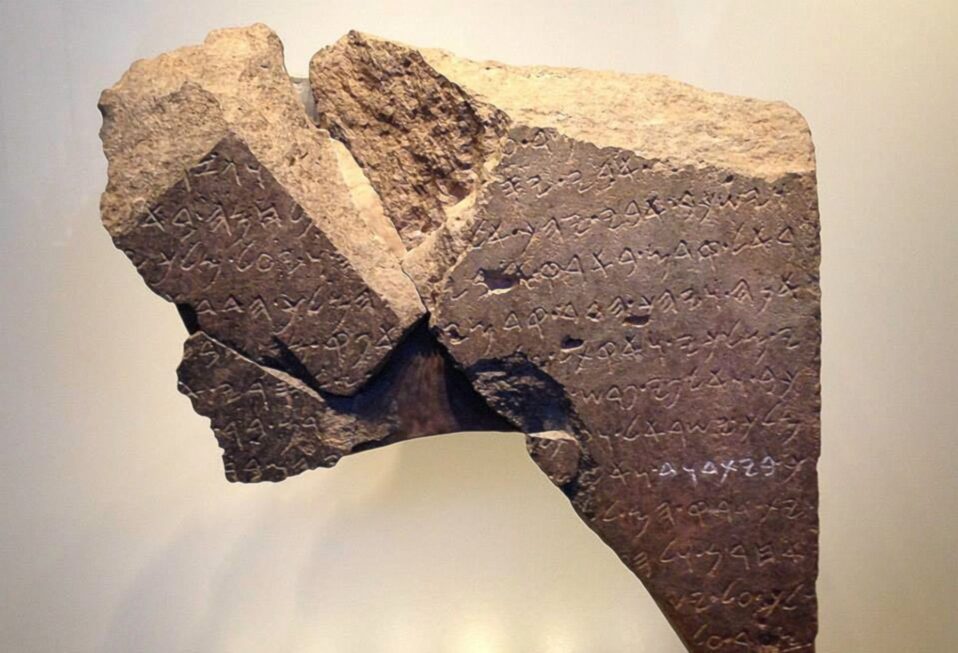Excavations in the 1990s at the site of Dan in northern Israel, which sits at the foot of Mount Hermon, uncovered three fragments of an inscription from the 9th century B.C. Written in Old Aramaic the fragments form part of a victory stela of an Aramean king (Hazael?) who claims to have killed the king of Israel and the king of the “House of David,” i.e., Judah. It seems that this stela was erected in connection with the events of the revolt of Jehu (2 Kings 9-10).
From its initial discovery, scholars have noted the significance of this inscription, and especially the mention of the “House of David” with reference to the king of Judah. This is the first ancient inscription that connects the royal house of Judah with David. Moreover, this language, “House (meaning a dynasty) of David,” appears a number of times in the Old Testament.
For example, in 2 Samuel 7, God makes a covenant with David that his heirs will sit on the throne in Jerusalem: “Moreover the LORD declares to you that the LORD will make you a house. When your days are fulfilled and you lie down with your ancestors, I will raise up your offspring after you, who shall come forth from your body, and I will establish his kingdom” (2 Samuel 7:11-12; see also 1 Kings 12:26; 14:8; 2 Kings 17:21; Isaiah 7:2; 22:22; Jeremiah 21:12; Zechariah 12:10; 13:1).
The inscription from Tel Dan indicates that within the 9th century B.C. the royal house of Judah identified itself as belonging to the House of David, as can be seen from the biblical text. Since the discovery of the Tel Dan stela, an inscription discovered in the 19th century in Transjordan, the Moabite Stone, which is also a victory stela of Mesha, king of Moab, has been reread, and some scholars have detected a reference to the “House of David” also in the Moabite Stone.
The Tel Dan inscription is also important because, if it refers to the rebellion of Jehu, it provides extrabiblical evidence that can shed light on how we understand this event recorded within the Bible. It suggests that Hazael, king of Aram-Damascus, and Jehu conspired in the rebellion, which may be hinted at in 1 Kings 19:15-18.
Marc Turnage is President/CEO of Biblical Expeditions. He is an authority on ancient Judaism and Christian origins. He has published widely for both academic and popular audiences. His most recent book, Windows into the Bible, was named by Outreach Magazine as one of its top 100 Christian living resources. Marc is a widely sought-after speaker and a gifted teacher. He has been guiding groups to the lands of the Bible—Israel, Jordan, Egypt, Turkey, Greece, and Italy—for over twenty years.
Website: WITBUniversity.com
Facebook: @witbuniversity
Podcast: Windows into the Bible Podcast




Comments(3)-

-

-





Josephine Davenport says
November 2, 2022 at 2:48 pmLove to read books of the old Israel. I’ll buy this book. Thanks
Janecaricohopper says
November 2, 2022 at 9:55 pmI Dearly Love everything. that is in kJV. Bible . that has been told in Jesus’precious name Amen!
Alton Coe says
November 3, 2022 at 11:25 amI’ve seen the copy (1 of 2 in existence) Moabite Stone that was on view in a small church in Salado Texas before it was moved to a museum in Glen Rose Texas. The translation were taught. Beautiful piece of history!!
Receive Devotionals and News Updates from Israel
Recent Posts
Streams in the Desert: Lessons from Avdat
Weekly Devotional: The Strength of a Calm Spirit
Torah Reading Devotional: Parashat Noach (נֹחַ) “Resting”
Freed Hostages: The Media’s Best Factual Source